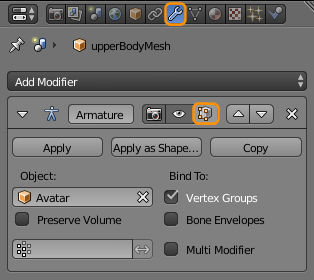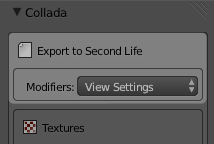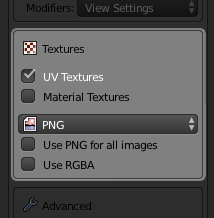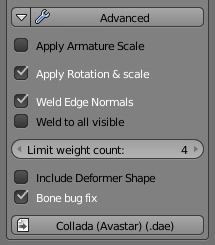Export your Character as Collada
The Collada exporter exports your Mesh character or mesh attachment to a form that is recognizable by the target System (SL, OpenSim or any compatible online world). You find the Mesh Exporter in the Tool shelf. The Collada Panel has quiet a few options. we explain all of them now
Hint: You usually can keep the default settings and just click on the “Collada(Avastar)(.dae)” button. A File Selector will pop up. Here you can navigate to your export directory and then export your file as a Collada file (using the file extension “.dae”)
Modifiers
By default Avastar applies all mesh changing Modifiers except the Armature Modifiers to the exported meshes. However, some modifiers have 2 sets of options, one option set is for rendering, the other option set is for the Viewport. We provide 3 options here:
- Apply according to the View Settings (the 3D Preview settings)
- Apply according to the Render Settings (the settings for Blender’s own Renderer)
- Don’t apply modifiers and only export the base mesh
The View settings will be applied by default. These settings are very closely related to the Blender Render System. In most cases you can actually just use the defaults. We will get back to this when we talk about how to use (or not use) Modifiers.
Armature Modifiers define a relation between your mesh and your Skeleton (Armature). You find the Armature modifier in the Modifer Stack (see image). Armature modifiers are always defined for the mesh. Armatures them self have no Armature modifier.
We will get to armature Modifiers in the “
Create an Attachment” tutorial.

Hint: You want to display the modifier in edit mode and adjust edit cage to modifier result
Textures export (advanced)
You can export images along with your models. In that case the images will be stored as extrafiles and a reference is added to the Collada file. The SL Importer knows how to read and import these images for static meshes.
Note: But for rigged meshes the images are not recognized.
- UV Textures & Material Textures: Blender supports Material based textures and UV textures (which are directly assigned to polygons). Normally you want to export only the UV textures. In rare cases it is more desirable to export the material based textures instead. But beware, Blender does not export the render results, but only the source images!
- Image Type: The image format is typically predefined in the Blender Render settings. However we found it convenient to provide an immediate setting in the Exporter. By default the image type will be applied ONLY to generated images.
- Use ‘Image format’ for all images: If this option is set, then Blender will use the selected image format for all exported images. If the option is disabled, then only the generated images will be affected.
- Use RGBA: Blender can export the Alpha channel for images. Normally this is controlled in the render settings where you can specify to use either RGB or RGBA for image exports. If the currently selected export format supports Alpha then enabling RGBA here will export images with Alpha channel even if the render settings are set to RGB and vice versa.
Hint: You may want to NOT use RGBA because of the Alpha glitch. However this is not a general advice. There are many situations where using Alpha images is even recommended (for example when you want to create an Alpha mask).
Hint: If the format of the exported image(es) does not support an Alpha channel then the “Use RGBA” option is simply ignored.
Advanced options
The Advanced Options are related to some special issues. You should normally keep the options set as they are. This ensures your exports are well suited for SL. However in some situations you will have to get back here and set the options according to the descriptions below:
Apply Armature Scale: If you have scaled your Armature in Object Mode for making a tiny or a giant you should not apply the scale to the armature because then the entire Avastar Animation system may no longer work (details need to be documented). But the Object Scale must be applied when you export the mesh.
Otherwise your scaling will not be recognized in your target online world and the giant shrinks back (or the tiny grows back) to normal size. The Applay Armature Scale option ensures that the Object scale is applied in the exported Armature.
Apply Rotation & Scale: If you have Scaled or rotated your Objects in Object Mode then this Scale&Rotation should be applied to all objects of an export to avoid unexpected scaling and rotation issues within the target system. However this is all so often simply forgotten and sometimes even unknown.
Hence we have added an automatic apply Rotation&Scale to the exporter. This setting does not affect the original objects.
Weld Edge Normals: When two separate objects share a boundary line, then you typically see a boundary seam in the object texture. This happens because the vertex normals differ even if the adjacent objects share the exact same vertex locations.
This option recalculates the vertex normals at the adjacent boundaries of the selected objects.
Weld to all visible: Sometimes you want to only export one part but still want the vertex normals be fixed.
This option lets the exporter take all visible objects into account when calculating the vertex normals at object boundaries.
Include Deformer Shape: Some virtual worlds support the Mesh deformer which was originally developed for usage in Second Life.
When this option is enabled, then an additional xml file is created that can be used as reference shape if the Importer supports this feature (currently used with OpenSim)
bone bug fix: We have found that some online worlds have serious issues with modified Joint offsets for Collision volumes and Attachments(1). Hence we suppress the export of joint offsets for collision volumes and attachment bones by default.(1): The technical details are related to the SL Importer’s option With Joint Positions The Skeleton can be modified (in edit mode) to create other rest poses than the default rest pose (T-Pose) When you do that, you actually move the Joint Offsets away from their default locations. And you will later have to set “with Joint Offset” during import in order to get your modified skeleton uploaded.
However this works only for the SL Basic bones (the mBones) All other Bones have various issues with Joint Offsets. The Collision Volumes do not work at all when you try to import them with Joint Offsets. We consider this an SL Bug. So we have added the Bone Bug Fix option. This option should only be disabled for experimental purposes! Handle with Care. You likely break the animation system.



